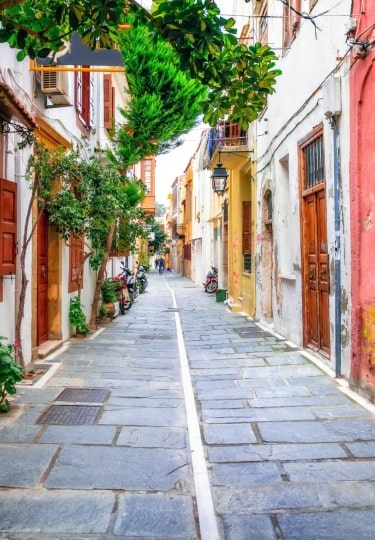There are an abundance of things to do in Crete, the fifth-biggest island in the Mediterranean. As a summer vacation destination, it’s best known for its historic Venetian-influenced ports, lovely towns, and stupendously amazing beaches.
Head away from the sands, though, and a whole other world unfolds: towering mountains, striking gorges, rushing rivers, and quaint mountain villages.
There’s history in those hills and on the island in general. Crete could well be its own country, and in the Minoan era was even its own empire, but has been ruled by many civilizations. All of them left some kind of legacy, whether it be food, architecture, or simply further fuelling the locals’ strong spirit of independence.
While that spirit still burns bright, Cretans also offer one of the warmest welcomes on the Greek islands. Stop for a Greek coffee or a glass of tsikoudia spirit and make a plan based around the best things to do in Crete, Greece.
Relax at the Old Venetian Port of Chania
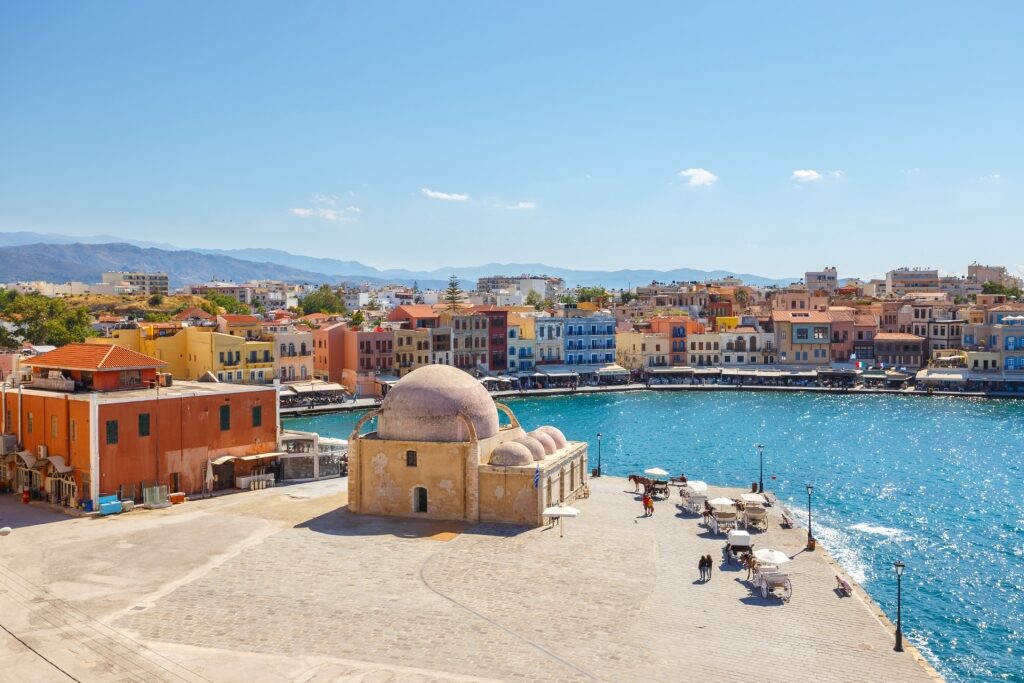
Old Venetian Port of Chania
Traveling to the Greek Islands can be like a trek back in time, from Rhodes’ magnificent medieval Old Town to lovely Little Venice in Mykonos. Chania’s Venetian-era port is right up there with them for its movie-star looks.
The port sits on an almost perfect arc and strolling the waterfront here is one of the best things to do in Greece. It’s lined with elegant mansions, a captivating mixture of Venetian, Ottoman-era, and neoclassical architecture.
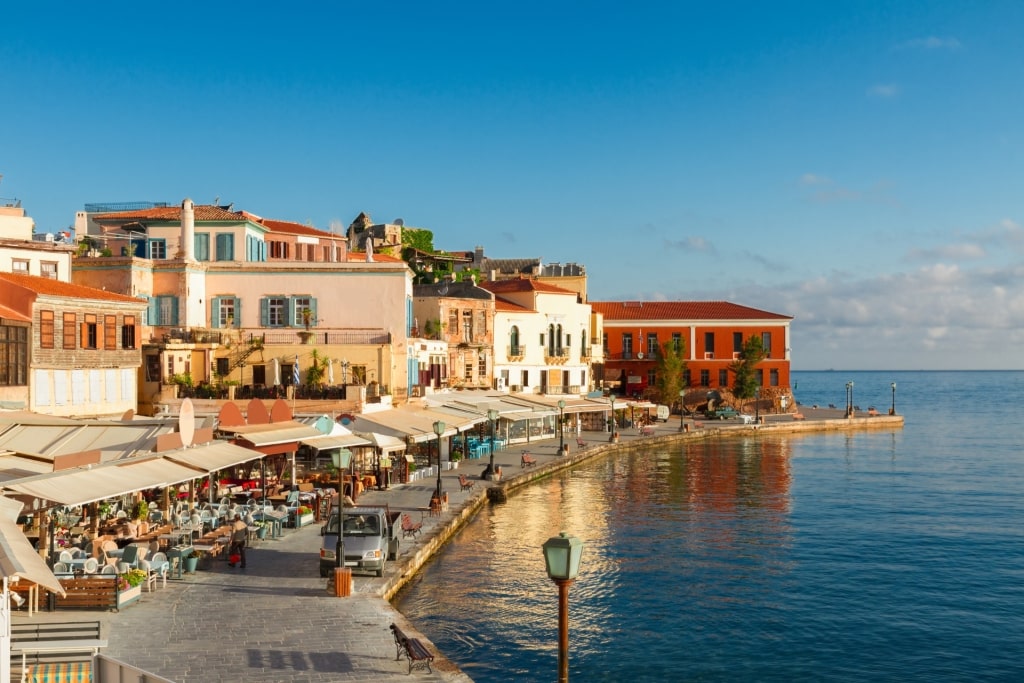
Old Venetian Port of Chania
These pastel-colored buildings provide a vibrant backdrop to the traditional fishing boats that line parts of the harbor. Not only is the setting uniquely beautiful but it’s also a great spot in which to watch the world go by while sipping on Greek coffee thick as molasses or trying a glass of refreshing ouzo, Greece’s traditional anise-flavored spirit.
Fishermen call out their wares, fresh octopus dry out in the sun ready for grilling on smoking charcoal, and locals stretch their legs with a late afternoon “volta” or stroll along the seafront.
Hike the Gorge of Therissos
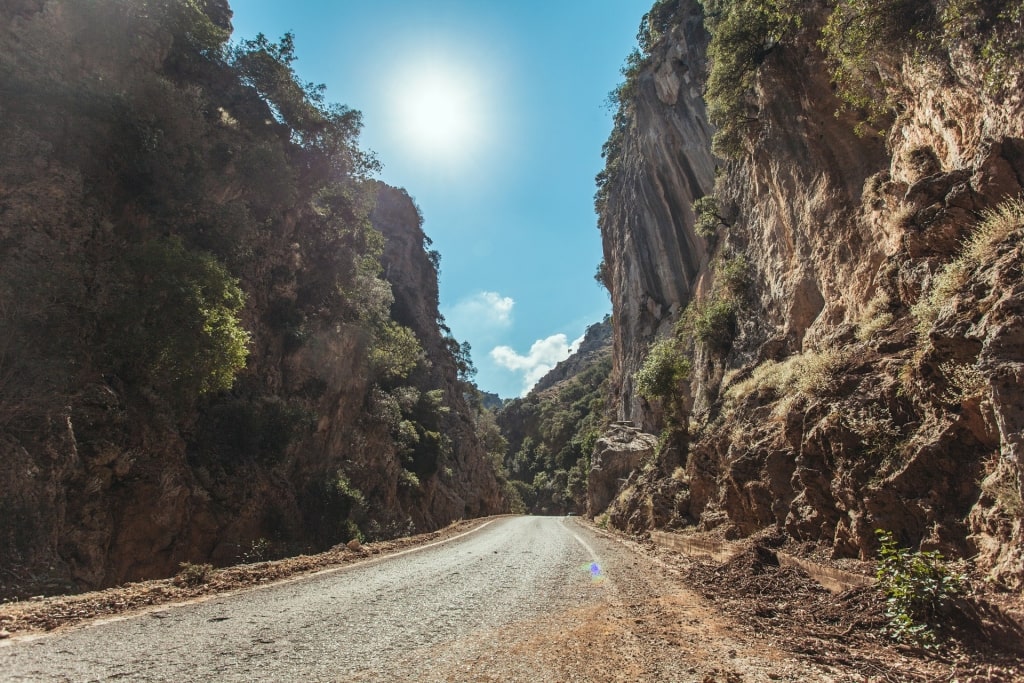
Gorge of Therissos
There are heroic deeds to be had in this five-mile-long gorge a short drive from the port town of Chania. The hike along its length is one of the best things to do in Crete, a bold claim given that Crete is riddled with deep gorges thanks to its mountainous nature.
The trail, which ranges from 50 to 250 feet in width, passes through incredible scenes with olive, orange, and oleander trees lining the way. It ends in the village of Therissos.
The limestone walls of the canyon echo with history. The village was one of the main bases for the resistance in the battle against Ottoman occupiers in the late 19th century. It was also once the home of revolutionary hero Eleftherios Venizelos. His former home is now a museum that tells the story of the rebel’s legend.
Read: Best Places to Go Hiking in Greece
Take a Jeep Tour of the White Mountains
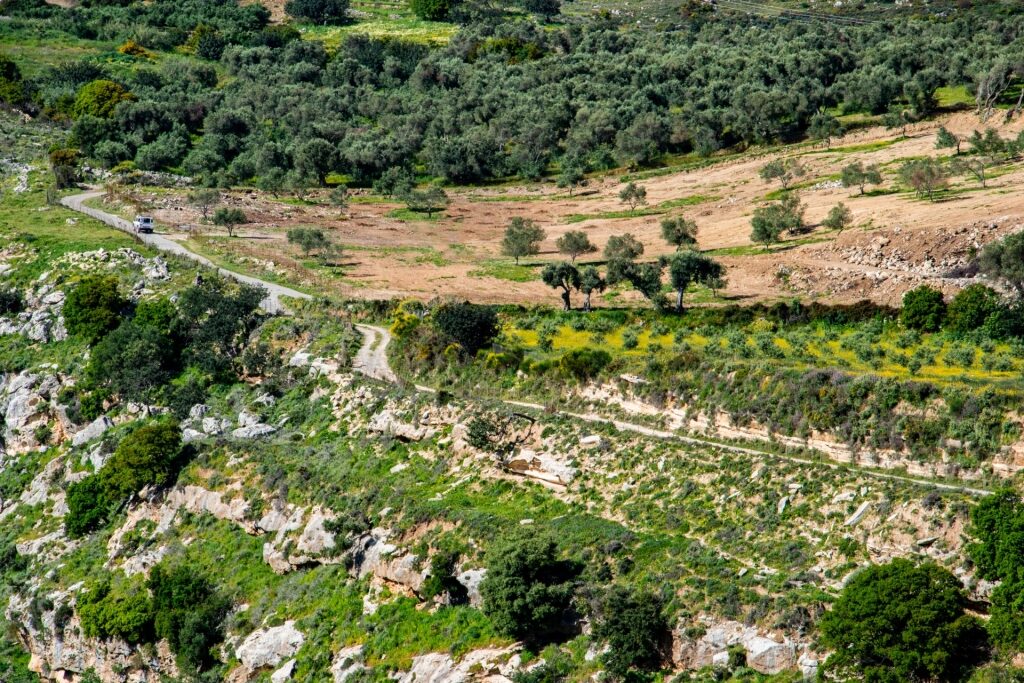
White Mountains
Crete is so big, it could well be a different country to the rest of Greece (and there are a fair few locals who firmly believe it should be, too). The island’s size makes for incredible topography: towering limestone peaks, deep valleys, rolling farmlands, and hidden bays along the hundreds of miles of coastline.
The White Mountains or “Lefka Ori” are so vast, they dominate the skyline south of Chania and cover most of the center of the Western Crete. With more than 30 peaks above 6,000 feet, they make for an incredible day of exploration.
You could easily spend a whole vacation here but if you’re wondering what to do in Crete and have limited time, the best way to get an insight into life in the hills is to explore by jeep. Organized tours take in tiny hamlets, traditional shepherd huts, and agro farms, while also offering the chance to sample hospitality, mountain-style, in a local taverna.
Hang Like a Hippy in Matala
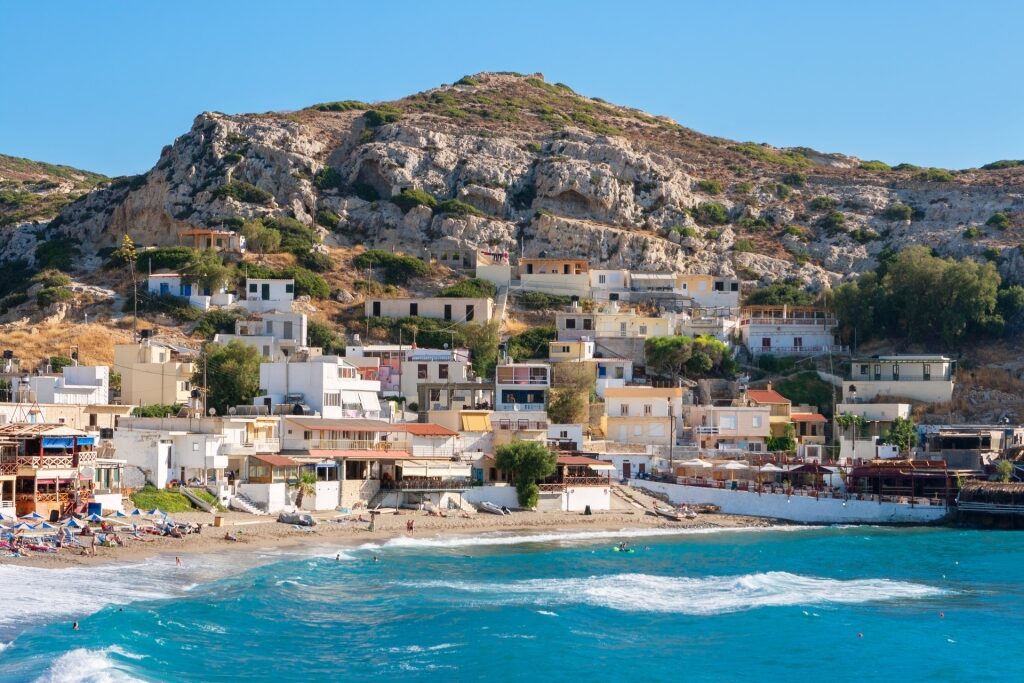
Matala
Matala, lying some 50 miles south of the port of Heraklion on Crete’s south coast, dates from the Neolithic era, when sweeping tides created a network of caves in the soft rock of the cliffs that surround what is now the town.
These caves were once Roman burial chambers but the 1960s saw them become a unique hippy hangout. Cat Stevens, Janis Joplin, and Bob Dylan all spent time here. While much of the town now is a more modern affair with its white cube houses, winding streets, souvenir shops, and a gorgeous beach, that flower power legacy can still be seen on some impressive carved tree trunks in the town center.
See Europe’s Oldest City at Knossos
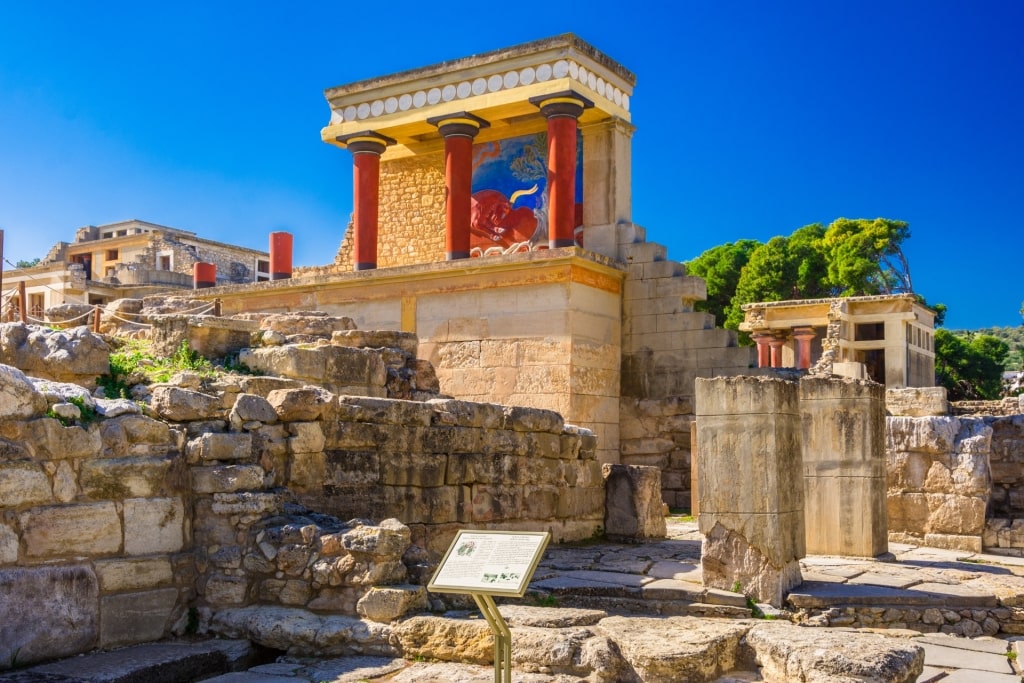
Knossos
Occupied since the neolithic era more than 7,000 years ago, Knossos is thought to be Europe’s oldest city. The main site, stretching over more than six square miles, was the epicenter of the Minoan civilization, an empire that spread to Athens and beyond.
At its heart are the remnants of what would have been a vast palace that in its heyday would have covered more than five acres between the main residence and its outbuildings.
As well as having huge architectural importance, this Greek landmark also serves as the inspiration for the myth of the Minotaur. This creature was half-man and half-bull and is said to have lived in a maze here and been the source of the Empire’s power.
Today, a visit to the site is one of the best things to do in Crete. A mixture of Greek ruins and recreations, it includes the palace, courtyards, and what would have been private apartments of the time.
Sample the Local Firewater
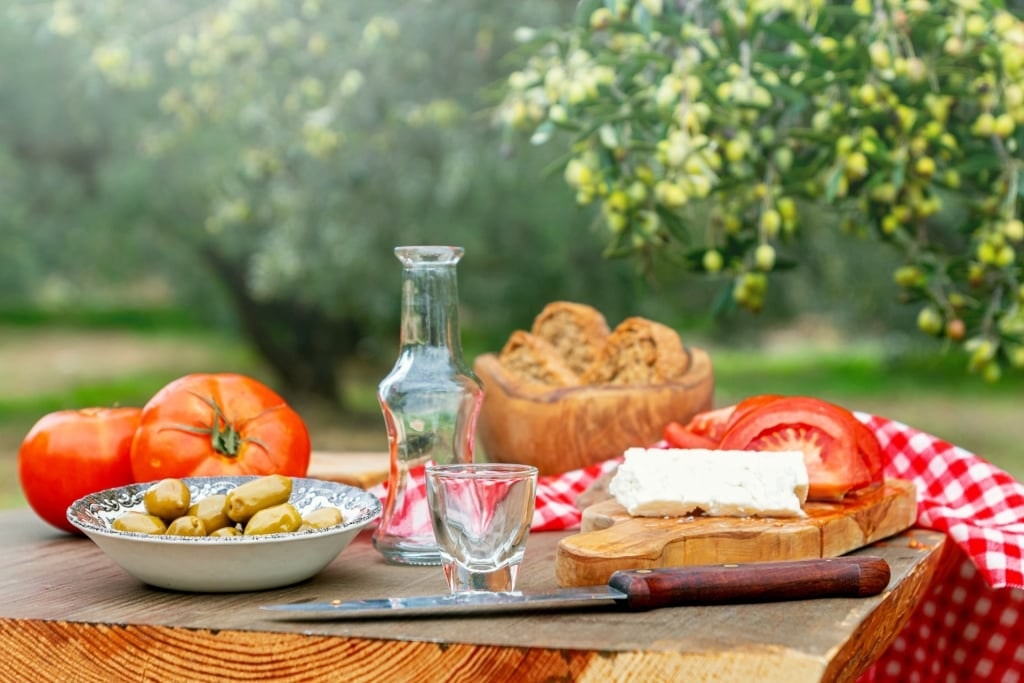
Tsikoudia
Many north and east European countries have their own high potency spirit, and in Crete, it takes on the name “tsikoudia”, a fragrant and clear grape-based pomace brandy that can reach up to 65% ABV. While this potent spirit is also known as “tsipouro” and “raki”, it differentiates from the Turkish version of raki in that it is not aniseed flavored.
Tsikoudia comes to the fore at most meals, especially celebratory ones, in Crete either as an aperitif or postprandial tipple. Either way, being offered a glass is a sign of welcome and friendship.
Served in shot glasses, either ice cold or on the rocks, it’s the kind of drink to be knocked back in one rather than sipped, although joining in too vigorously may see that glass quickly refilled for another round.
Take a Dip at Agioi Apostoloi Beach, Chania
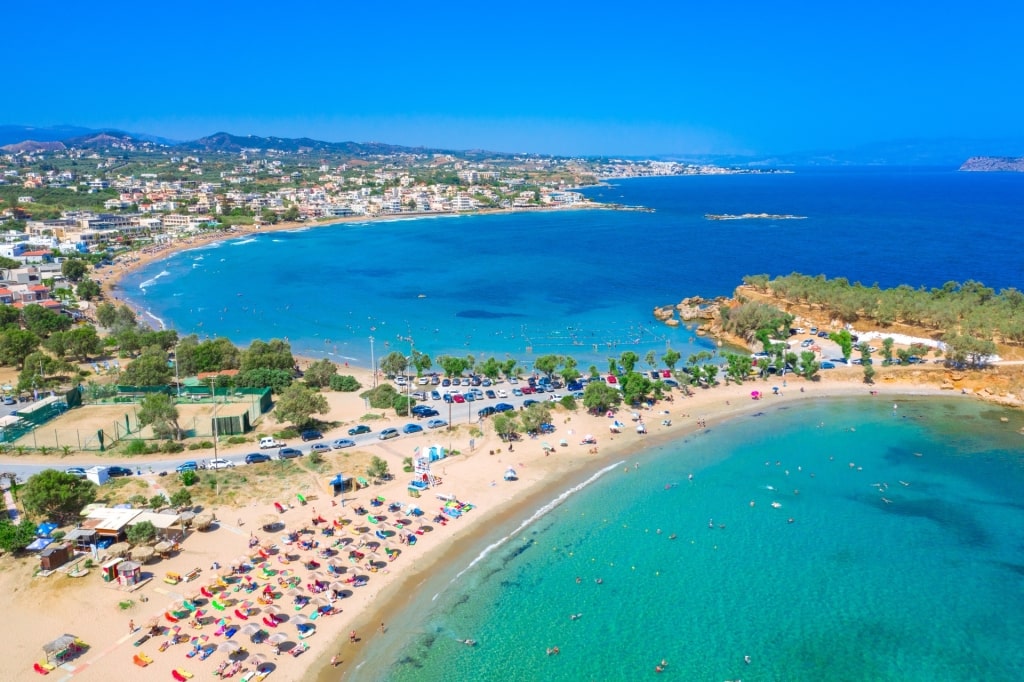
Agioi Apostoloi Beach, Chania
Crete is home to some of Greece’s best beaches, most of which lie outside the main cities of Heraklion, Rethymnon, and Chania, meaning transport can be an issue if you don’t rent a car. Not so with Agioi Apostoloi, a pair of lovely beaches less than two miles from Chania’s Old Town.
The two beaches are separated by a T-shaped headland that offers both some charming forest walks and protection from winds. The ocean here is mostly calm and therefore perfect for less confident swimmers.
To the west of the peninsula lies Glaros Beach, covered in fine sand and closer to Agioi Apostoloi (Saint Apostles) Church from which the beaches take their common name. On the eastern side, the beach is known as Chrysi Akti (golden coast) thanks to its richly colored sands. Both beaches have sunbeds, showers, and umbrellas, as well as cafés and beach bars.
Go Fishing in Agia Pelagia
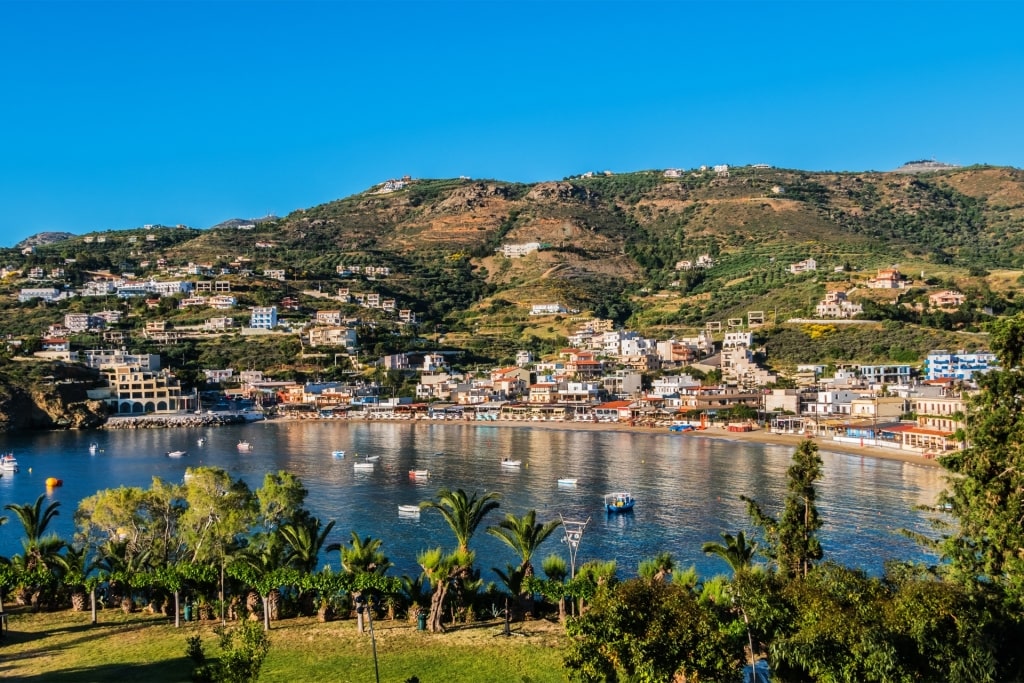
Agia Pelagia
On a small cove between the towns of Heraklion and Rethymnon lies the tiny resort town of Agia Pelagia, famed for its wide crescent beach lined with sunbeds and umbrellas.
The whitewashed church from which the town takes its name dates from the Venetian era, when this would have been a small fishing hamlet. There’s still the chance to collect a rod and tackle and head out on a fishing boat from the town’s port.
Sea bass, mullet, and Mediterranean moray are some of the most likely catches, but tuna and mahi mahi are not unknown, either. The rocks around the islet off Dia are great for bottom feeders and even if the catch of the day is poor, there’s still the chance to see loggerhead sea turtles and the occasional dolphin.
Read: Best Things to Do in Heraklion
Enjoy the Pink Sand at Elafonissi Beach
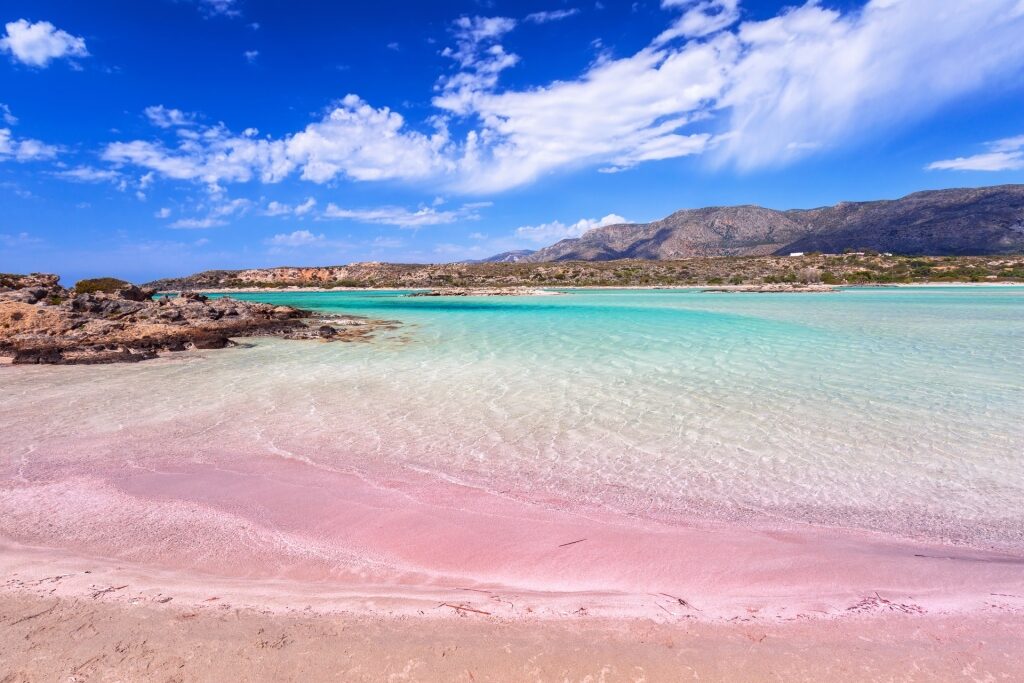
Elafonissi Beach
On an island that is teeming with amazing beaches, Elafonissi is one of the very best. Set on the south-west coast, a 90-minute drive from the port of Chania, it’s certainly worth the trek.
Technically an islet that can be walked to across a sandbank when the tide is low, there are vast stretches of pink sand beach on both the Elafonissi and Cretan sides. This means that although the beach is incredibly popular, it never seems too crowded.
The Cretan side is more “organized” with sun loungers and a beach bar, while the islet side is a little more remote, meaning secluded spots can be found along its far reaches. Either way, it’s hard not to be wowed by the Caribbean-style feel to this gorgeous south-coast spot.
See the Island of Spinalonga
Just offshore in the Gulf of Elounda, an hour’s drive from Heraklion, is one of the most poignant things to do in Crete.
The barren, rocky island of Spinalonga has a checkered history. Fortified in ancient times, it became an important bastion in the Venetian era to protect the island from pirate invaders.
Since then, its fortunes have fluctuated. First, the island was used as a rebel base in the battle against Ottoman occupiers. Then, it became a flourishing Muslim settlement after Cretan independence.
In 1903, Spinalonga was designated a leper hospital with thousands sent there to see out their final days, supposedly in solitude and living on state handouts.
Instead, they chose to organize a community, married one another, and had children, despite the bleak circumstances. The colony was closed in the late 1950s and the island was abandoned for many years before becoming a monument to human spirit. The story of its last inhabitants is told in a series of moving exhibits.
Step Back in Time in Anogia
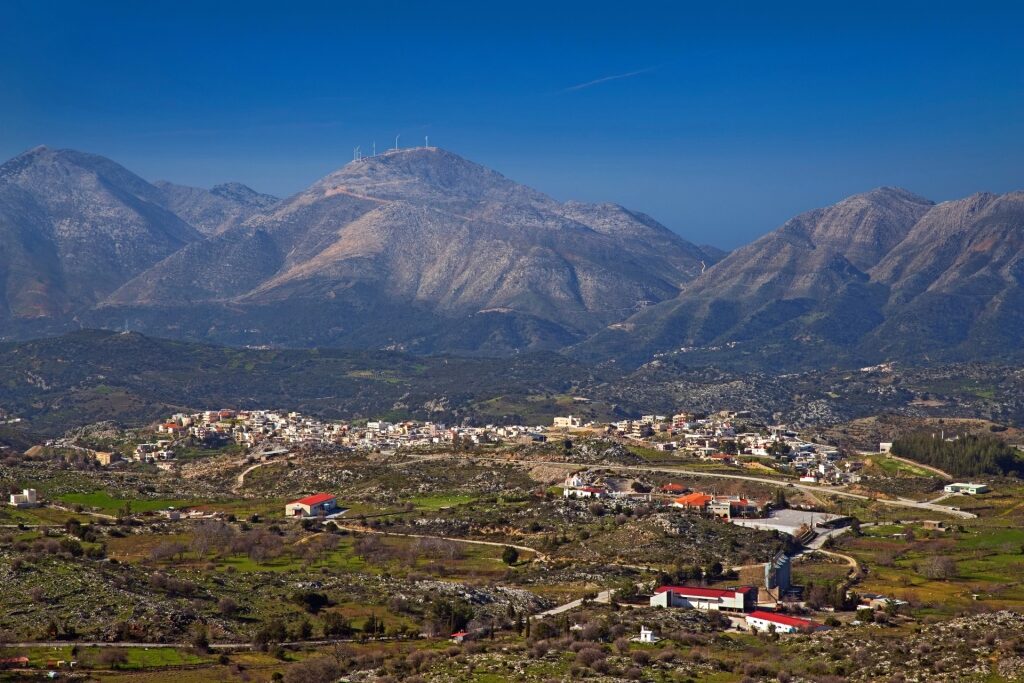
Anogia
Set at an altitude of some 2,100 feet on the slopes of Crete’s highest mountain, Mount Ida (locally known as Psiloritis), Anogia is one of the most traditional villages on the beautiful island. Here, the winding streets are redolent of old Crete, a time when life was much slower than in the 21st century.
At its heart is the tree-shaded square of St George, often home to free performances of folk music and dancing, while shops sell traditional woodcut art and embroidery.
The village is also the starting point for those wishing to summit Ida for a glimpse of the stone church of Timios Stavros at the highest point, 8,000 feet. Nearby, there’s also Sfendoni Cave to explore, with impressive stalactites and stalagmites.
Drink From the Lionhead Fountain in Spili
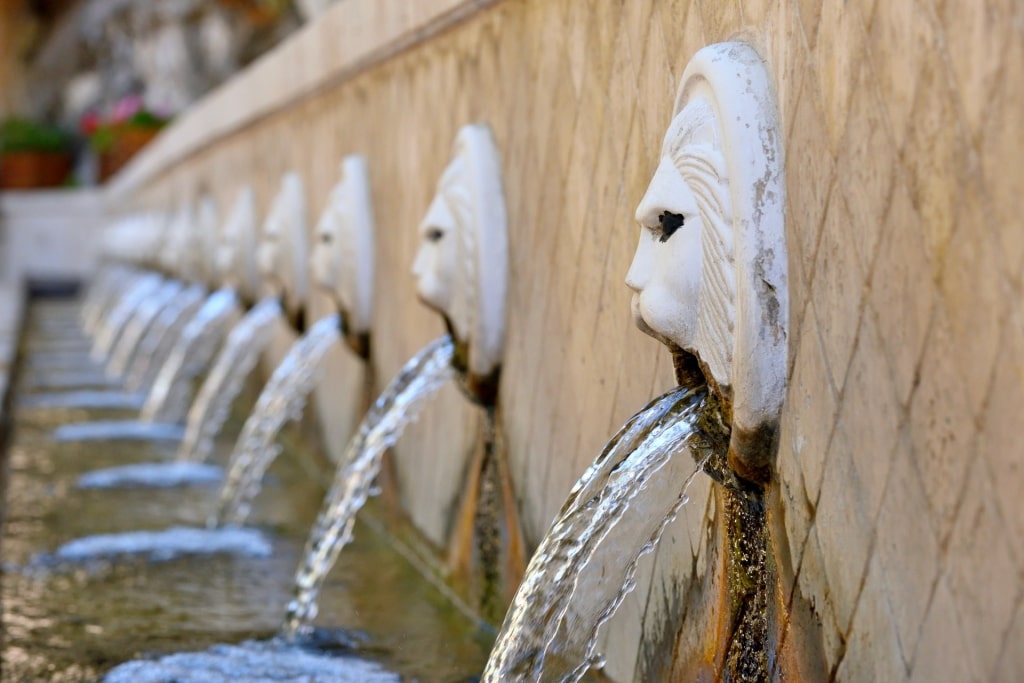
Lionhead Fountain, Spili
Spili means “cave” in English and this traditional hamlet is named after a series of caves in the surrounding hills. With a population of just 800 and sitting by the verdant Amari Valley right between the north and south coasts, the village is not only impossibly pretty but is famed for its natural spring water.
At the heart of the village is the “kefalovrissi”, a series of lionheads at the spring’s mouth that act as a spout for the flowing water, said to be rich in iron. The fountain sits under shaded plane trees and the surrounding buildings host tavernas with local cuisine, pretty cafés, and shops selling folk art.
See Minoan-era Tombs in Archanes
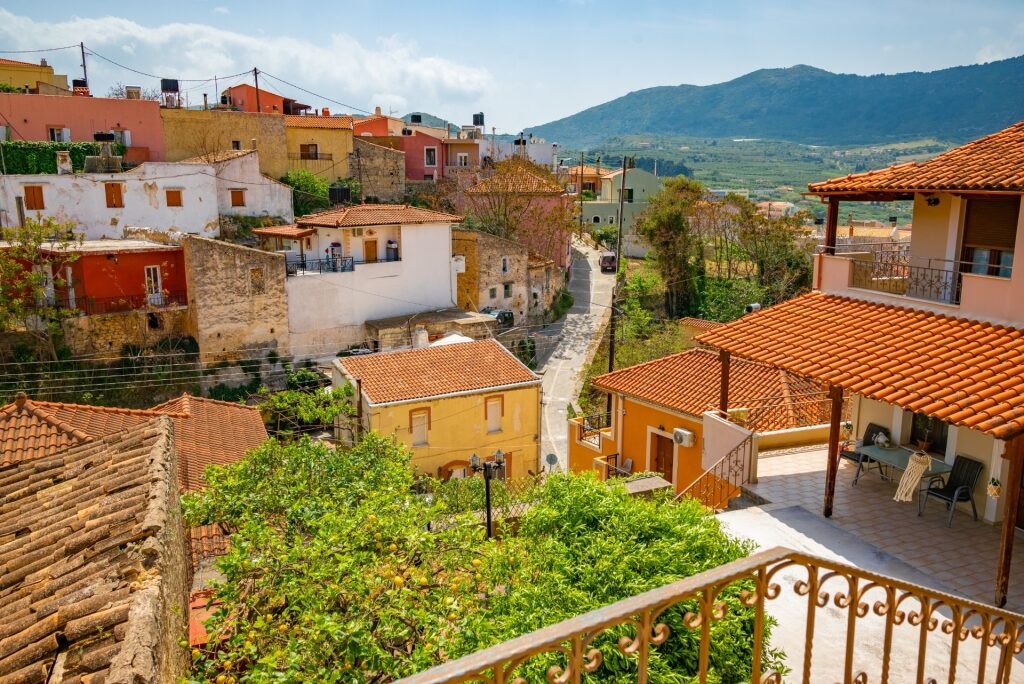
Archanes
A 20-minute drive from the capital, Heraklion, Archanes is a mountain village divided in two. “Kato” (or lower) Archanes sits in the valley, while “Ano” (upper) is the larger of the two and the main reason to visit. The villages have recently been restored with European Union funds, winning them an award as the best-restored village in Europe.
That claim aside, the area has been inhabited for more than 5,000 years and at its height, it was a Minoan city second only to Knossos in importance. Today, the remnants from that city can be seen across a series of excavations. The surrounding agricultural land is home to fields of olive trees and grapevines and the local wines are said to be among the best on the island.
Climb the Rock of Charakas
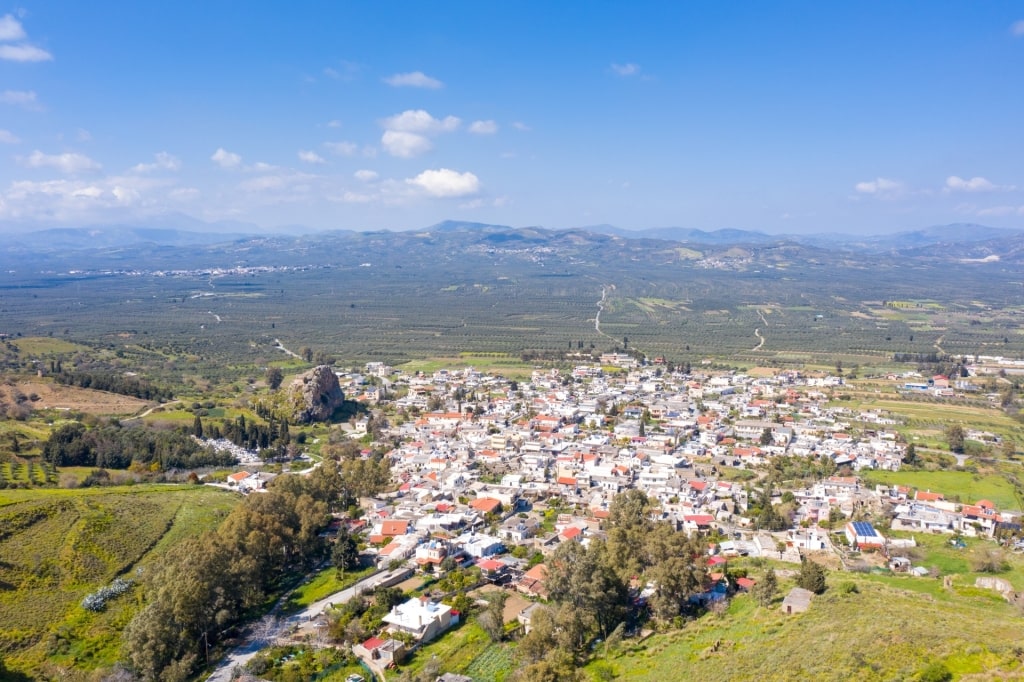
Charakas
Overlooking the planes surrounding Mount Asterousia, the imposing rock of Charakas is a 120-ft limestone formation. Its summit is reached by a pleasant hike that leads to a 14th-century Venetian fortress and a Byzantine-era church that has been restored to its former glory.
At the summit, there are incredible views as far as the south coast that make for great images. The rock also gives its name to a tiny village of around 1,000 people, all living in stone houses, as well as a number of small churches and local tavernas that are great for post-hike respite.
Pay Tribute to the 10 Martyrs of Agioi Deka
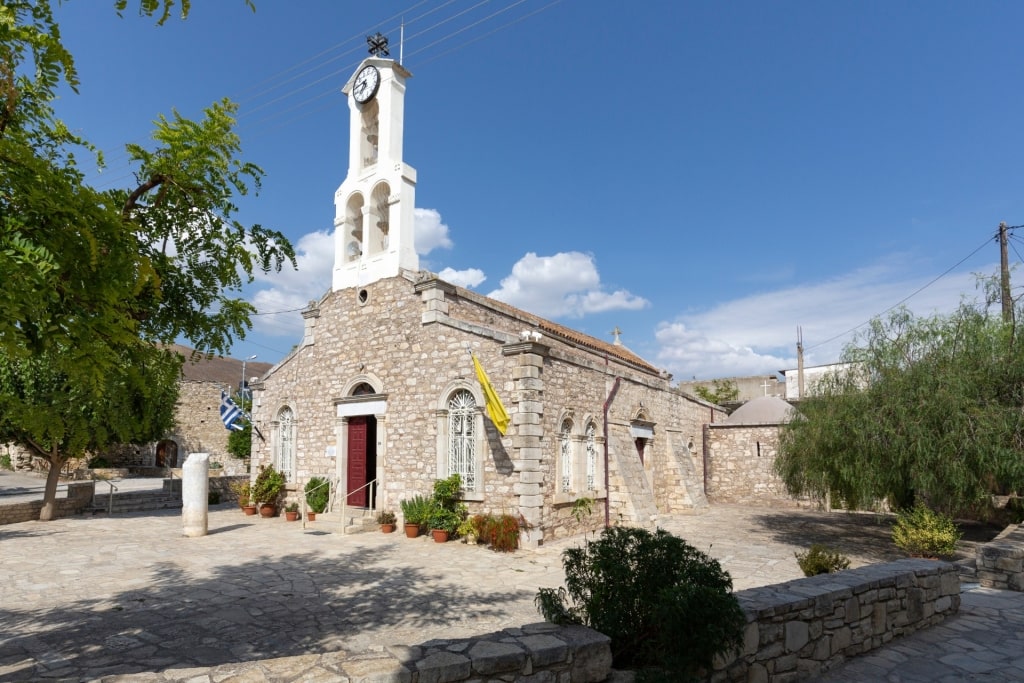
Agioi Deka
When the Romans ruled Crete in 250AD, the then emperor Decius embarked on a series of religious persecutions that saw 10 residents of this tiny village an hour south of Heraklion martyred.
The village is named in their honor—Agioi Deka means the “saintly ten”—and its home to a Byzantine basilica that is dedicated to them, as well as a more modern shrine that sits on the spot where they were buried.
Close by is also the ruined city of Gortys (many of the homes here are said to have been built with materials from the site), and there’s an archaeological museum containing finds from the area.
See the Bungee Jumpers at Aradaina
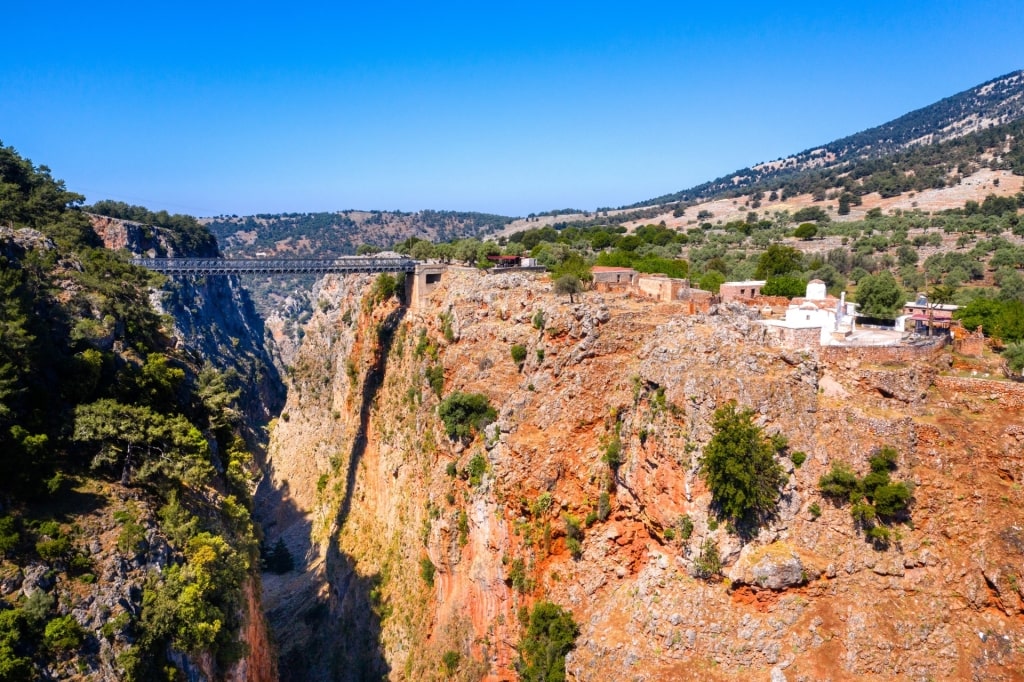
Aradaina
For adrenalin lovers, plummeting 460 feet from the Aradaina military bridge while attached to a bungee cord is one of the best things to do in Crete. The bridge spans the canyon of the same name and every weekend through summer, people line up to take this leap of faith, the second highest such jump in Europe.
It’s quite the sight, even if you’re not jumping yourself, to see them plummeting to the river below, only for their fall to be arrested by the rope.
The jump is close to another pretty mountain village worth visiting. Anapolis (or “upper city”) takes its name from its position, high in the White Mountains at an altitude of some 2,000 feet.
Drink in the Waters of Zaros
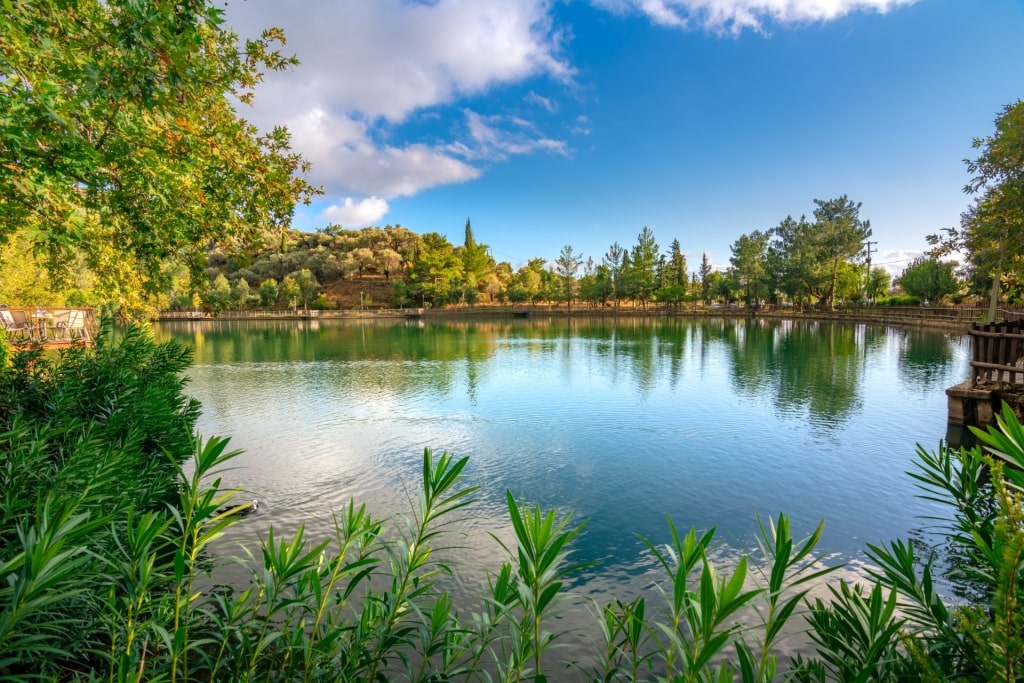
Zaros Lake
The natural springs in the village of Zaros, set in the foothills of Psiloritis, give rise to Crete’s most popular bottled mineral water that shares its name with the village itself. The water won the title of “world’s best” back in 2017.
The spring water gushes from the hills and flows into the manmade Zaros lake from where it is transported to the nearby factory for bottling.
Aside from factory tours, there’s a host of things to do here, from chilling beside Lake Votomos to hiking through the Agios Nikolaos Gorge. There are also several fish farms with lakeside tavernas offering freshwater trout and salmon as their specialties.
Dive into Balos Lagoon
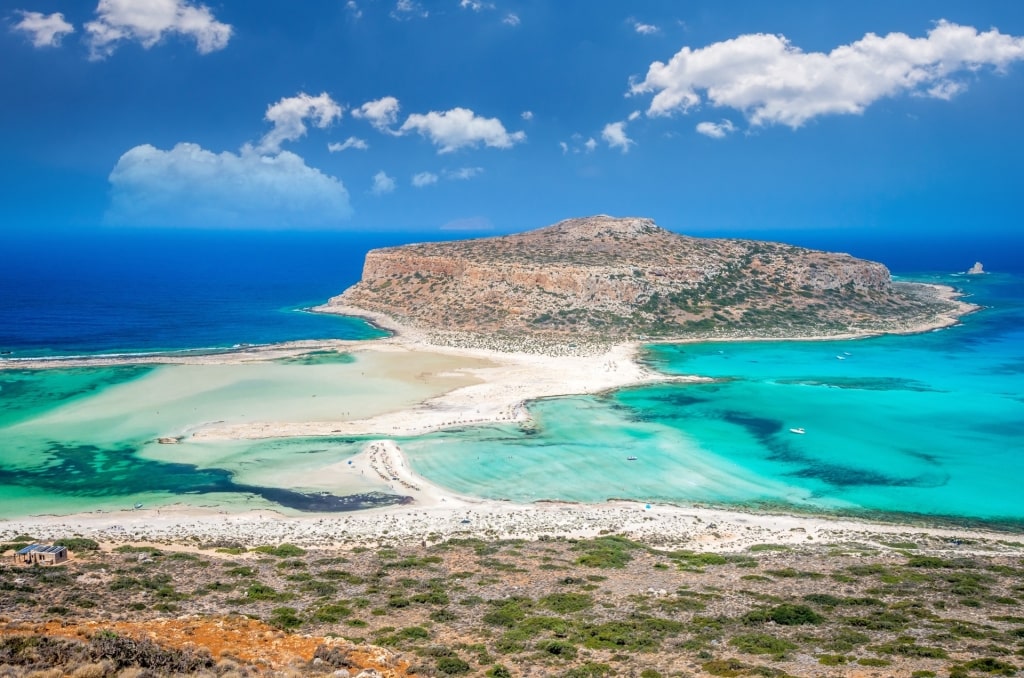
Balos Lagoon
Crete’s most famous beach is that of Balos, a remote lagoon approached by a rocky mountain road on the far west coast, some 40 miles out of Chania. You’ll be glad you made the effort when you see the beach on offer.
With ice-white sand and turquoise waters, there’s a real tropical feel here, and while the main beach can be busy in summer, there are plenty of small coves in which to find solitude.
On the hills above the beach there’s a viewpoint which is worth visiting for jaw-dropping shots of the beach below, as well as the islets of Agria Gramvousa and Imeri Gramvousa just offshore. The latter is home to an impressive medieval castle, as well as the remains of a shipwrecked boat.
Take a Cooking Class in Vamos
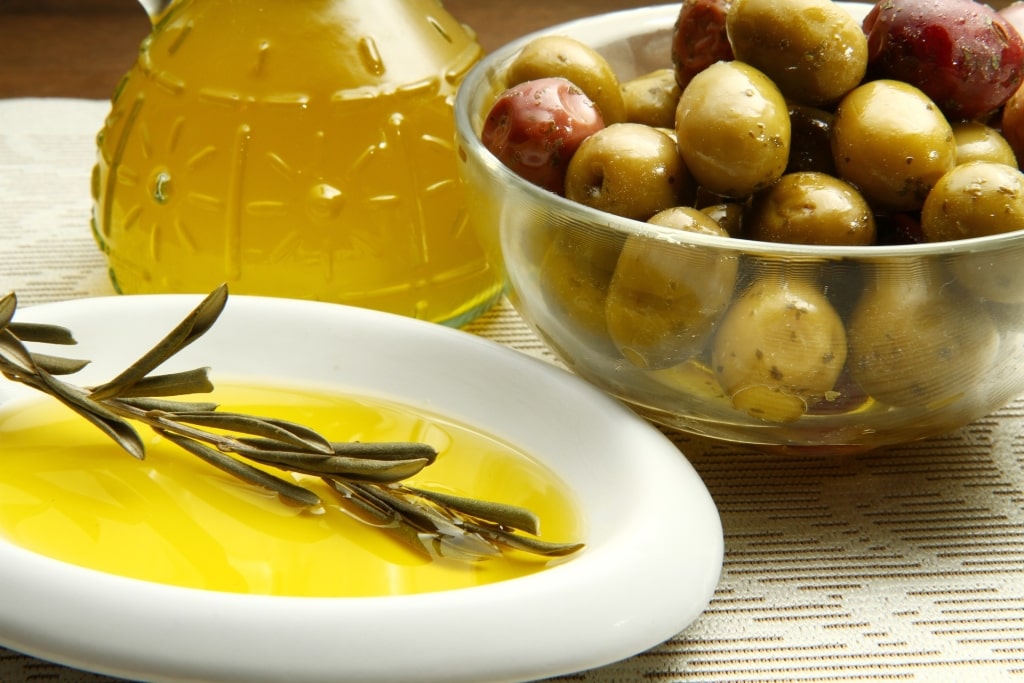
Olive oil
Cretan cuisine is incredibly tasty, largely thanks to the fact that the simple dishes are made from some of the best ingredients available: olive oil, vegetables, cheese, meat, and wine that are locally produced and mostly organic.
In the small village of Vamos, a 30-minute drive from Chania, cooking classes are held in a building that was formerly a traditional olive oil press. Over the course of a day, guests learn how to make four to five dishes using locally sourced ingredients.
The village itself deserves a mention, too. Formerly a pirate settlement dating from the eighth century, it was the headquarters of the invading Ottoman army in the 1700s. Now it’s home to well-preserved architecture that lines stone roads, while the surrounding fields are agricultural with almond, fig, lemon, and olive plantations.
Enjoy a Wine Tasting Tour
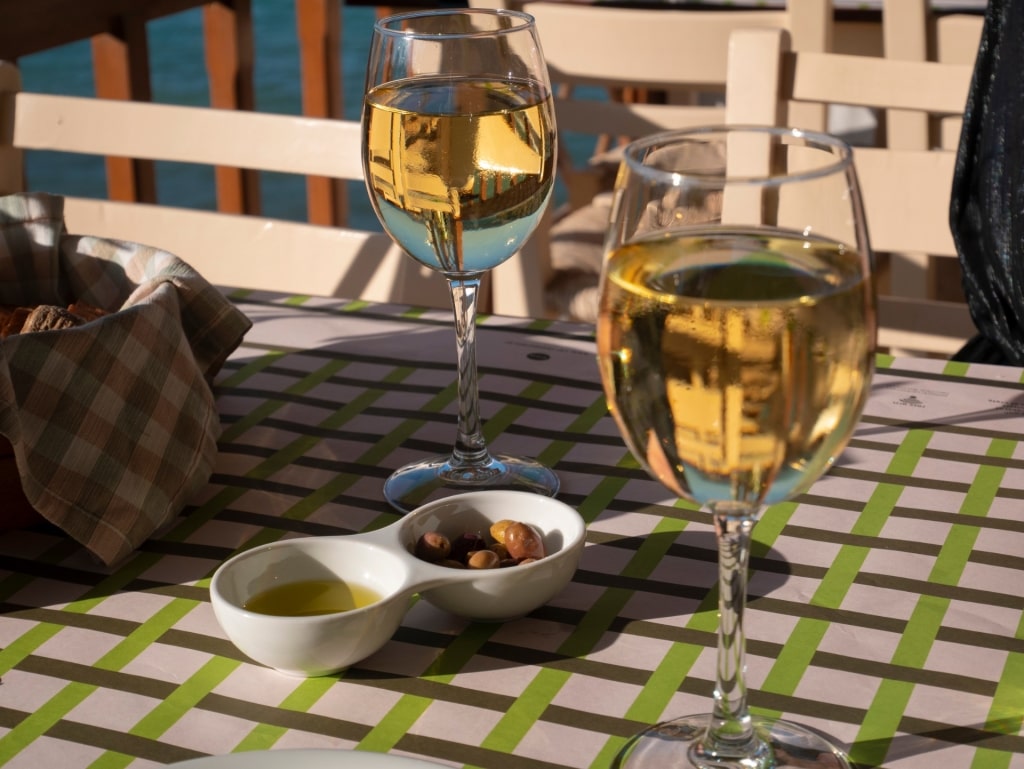
Wine
Viticulture has been present in Crete for some 5,000 years, since the Minoan period. In the middle ages, Malvasia sweet wines from Crete were considered so valued they were shipped from here to the rest of Europe.
The fine tradition continues today and the Mediterranean island is home to more than 60 wineries, making it Greece’s second largest wine producing region. Most of these offer tours and cellar door sales.
Look out for crisp whites with tropical notes from the plyto and vidiano varieties, with deep, rich mandilari and light, fruity liatiko leading the way among the reds. Well-known producers include Lyrarakis, Douloufakis, and Tamiolakis.
Visit the Old Town of Rethymno
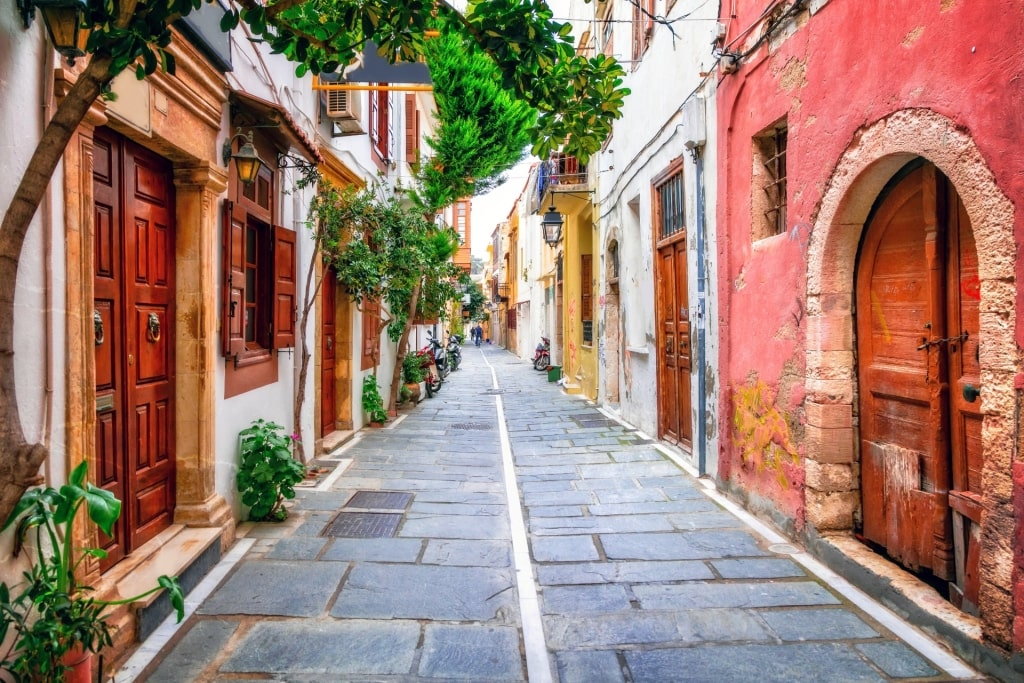
Old Town of Rethymno
Crete’s third largest city is a much more compact affair than both Heraklion and Chania, but no less worth visiting. One of Greece’s best-preserved medieval towns, it is famed for its Venetian fortifications, elegant mansions, orthodox and Catholic churches, and magnificent mosques.
As with the Greek city of Chania, the port area is a delight, stretching from the Venetian-era Fortezza castle to sandy Rethymnon beach, a great place to cool off in the summer heat.
There’s some great shopping to be had here, too. The winding, cobbled streets of the Old Town are home to clothes shops, jewelry stores, and art galleries, as well as Greek souvenir shops for those looking to take home a special trinket. Those same shaded streets offer some great lunch spots, too, from traditional tavernas to cute cafés and high-end eateries.
Enjoy the Botanical Gardens at Fournes
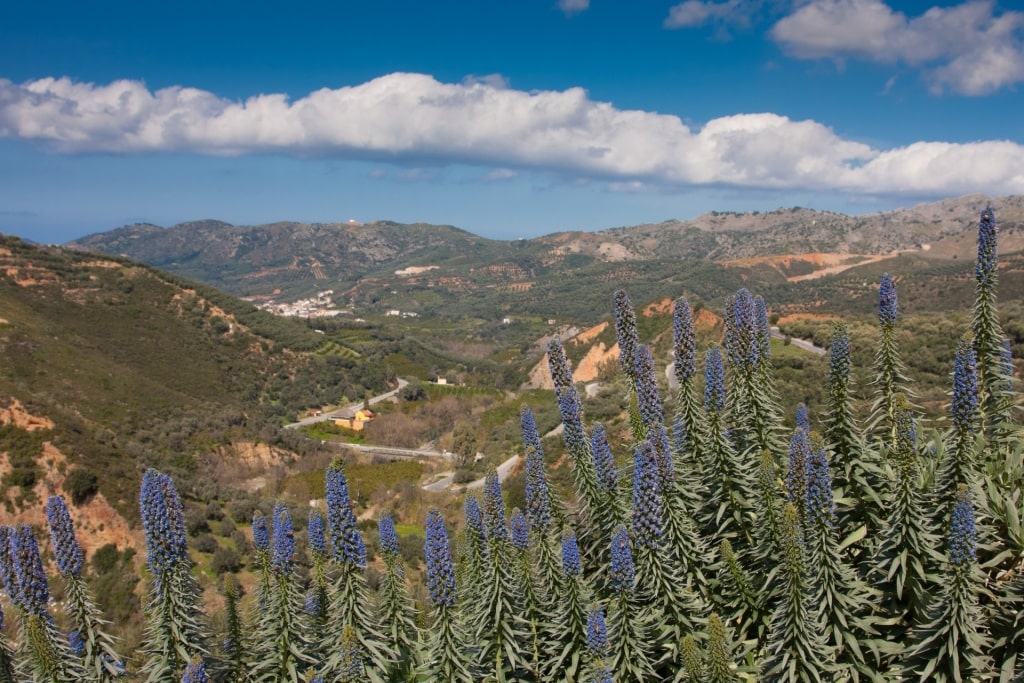
Botanical Park & Gardens Of Crete
At times tragedy can give birth to something beautiful. Case in point are the Botanical Park & Gardens Of Crete outside the town of Fournes, just south of Chania. The gardens are built on the site of a 2003 fire that destroyed more than 100,000 olive trees, some of which were over 400 years old. This catastrophic event left great swathes of land with nothing more than a covering of ash.
Undeterred by the destruction, land owner Petros Marinakis vowed to create an educational space for future generations and the park now houses more than 150 species of fruit trees, herbs, medicinal, and ornamental plants.
The gardens are lined with paths to walk and quiet places to enjoy the stillness, while there’s also a lake and a stone amphitheater for performances. At the park’s heart is a single charred olive tree, a reminder of the importance of preserving the great outdoors.
Visit the Markets of Chania
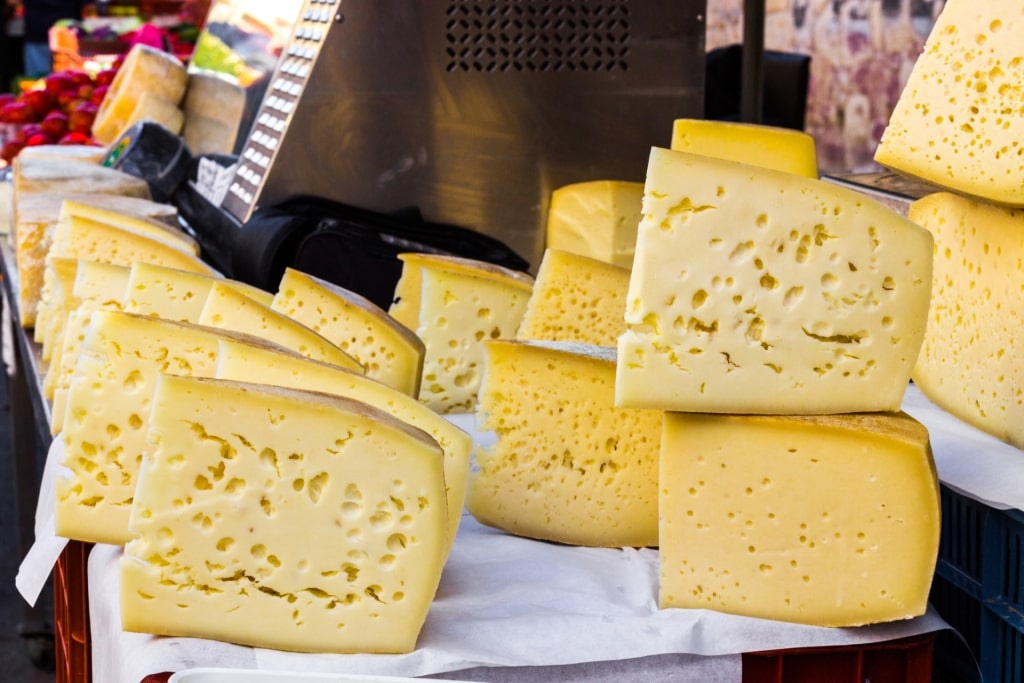
Market in Chania
One of the best things to do in Crete is to pay a visit to the street markets of Chania, which are held four times a week at various locations around the city center. Locals wait in line to pick up fresh fruit and vegetables, pungent homemade cheeses, fragrant dried herbs, as well as honey, live chickens, and rabbits, all from small producers.
A separate section of the market also offers clothing. If you want to sample life like a local for a few hours, these street markets are the place to do it.
Marvel at the Ancient Theater of Aptera
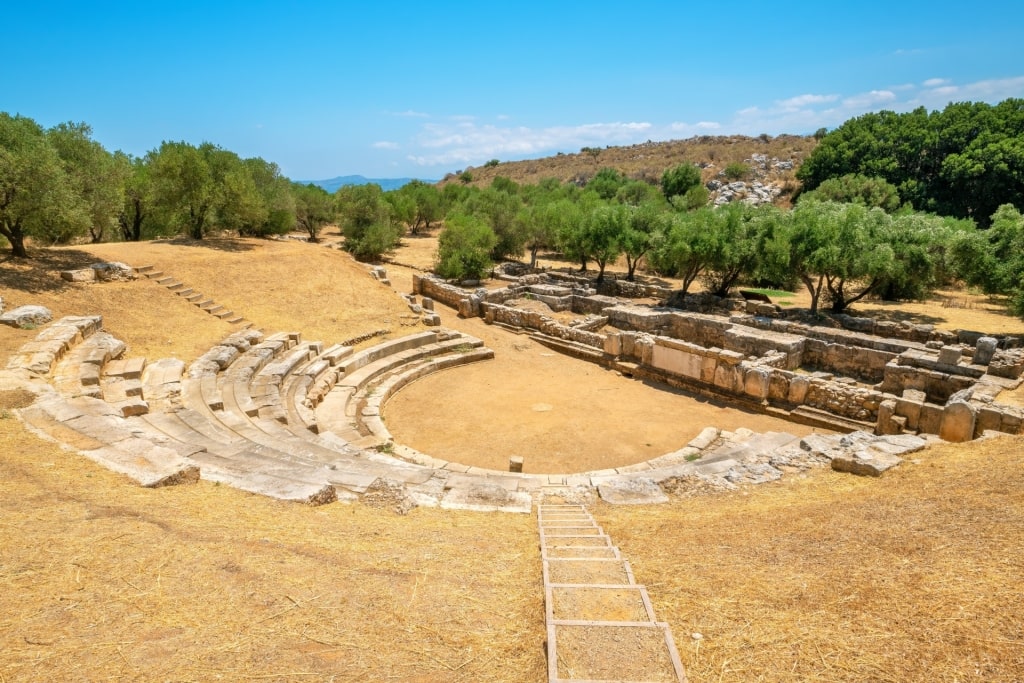
Ancient Theater of Aptera
Set between the Bay of Souda and Crete’s White Mountains lies one of the island’s most outstanding non-Minoan architectural sites, the ancient theater of Aptera. Dating from the early Hellenistic period, the ruins, made of local limestone, show it had an auditorium, orchestra pit and stage.
Roman modifications from the first to third centuries BC indicate the addition of bath houses and cisterns, though new discoveries are being constantly made by the archaeologists who work on the site on a regular basis.
Go Rafting on the Kiliaris River
Water flowing from the White Mountain peaks of Varsamou and Mavri heads down tributaries to create the Kiliaris River, at three miles long, the second longest in Crete. Stretching from Stylos village to Kyani Akti near Kalives, it offers some great rafting for beginners who can travel along a 1.5-mile stretch with some gentle grade 1 and 2 rapids.
Along the way, the river passes ancient watermills, the 1898 chapel of St John the Baptist (at which there are picnic tables for a pleasant activity pause) and forests of plane trees. This is an important wetlands habitat and rafters may also spot a number of birds, turtles, crabs, and toads.
Enjoy Lake Kournas
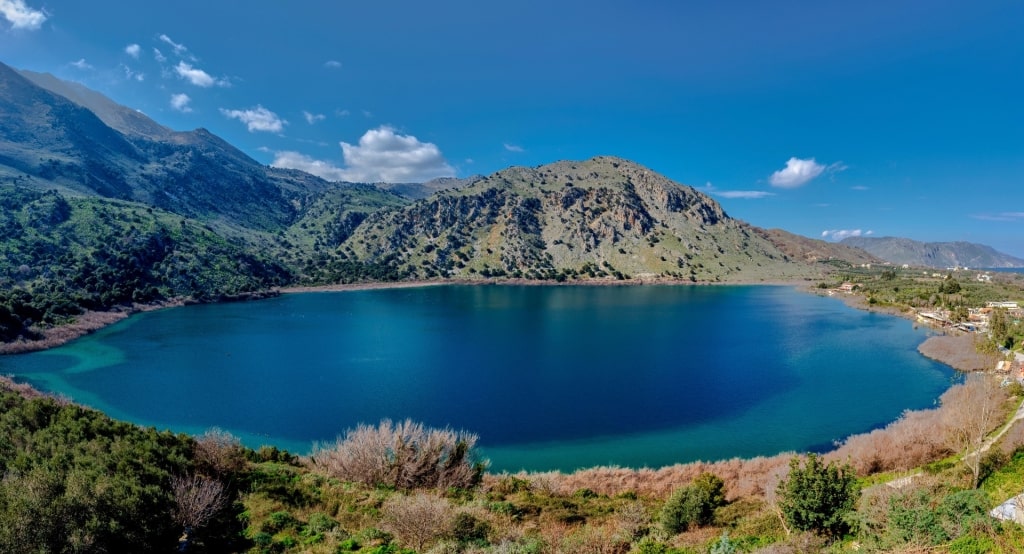
Lake Kournas
Crete’s only freshwater lake lies on the plains of Georgioupoli and is yet another significant body of water fed from the peaks of the White Mountains. Set against the backdrop of these Greek mountains and surrounded by forests, it’s a lovely spot away from the beaches in the height of summer.
To the southwest, there is a nature preserve that is part of the Natura 2000 Network and home to rare plants and trees. These provide a habitat for more than 130 species of birds, including coots, ducks, and herons.
As waters recede in summer, several small coves of white sand are found around the shore making for ideal swimming spots, and there are several companies offering pedalo rental, too. The eastern shore, meanwhile, has several lakeside cafeterias and tavernas, all offering views over the pretty setting.
Go Back in Time at the Arkadi Monastery
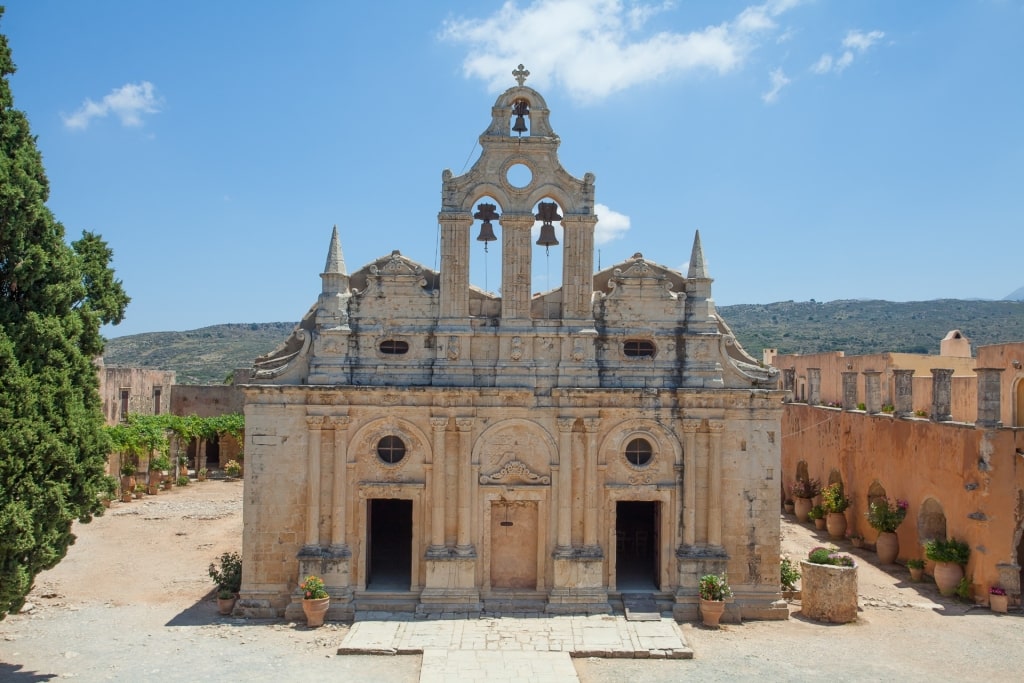
Arkadi Monastery
Crete is known as one of the best Greek Islands for beaches, mountains and amazing food, but one of the things that certainly deserves much more attention is its monasteries. There are more than 20 of these spiritual sanctuaries spread around the island, all of them incredibly beautiful, but the one at Arkadi stands out for both its architecture and its history.
Dating from the 16th century, it is built in the Renaissance style with Baroque and Roman influences. It played an important role in the 1866 Cretan revolt against Ottoman rule when 943 people sought refuge here, sacrificing themselves by blowing up barrels of gunpowder after a three-day siege.
Today the monastery, a much more peaceful affair, is home to seven monks, and visitors can take in the main church, the dining room, cellars, a museum, and an art gallery. Do note that visiting a monastery in Greece requires all visitors to cover their knees and shoulders.
Go Horseback Riding in Georgioupoli
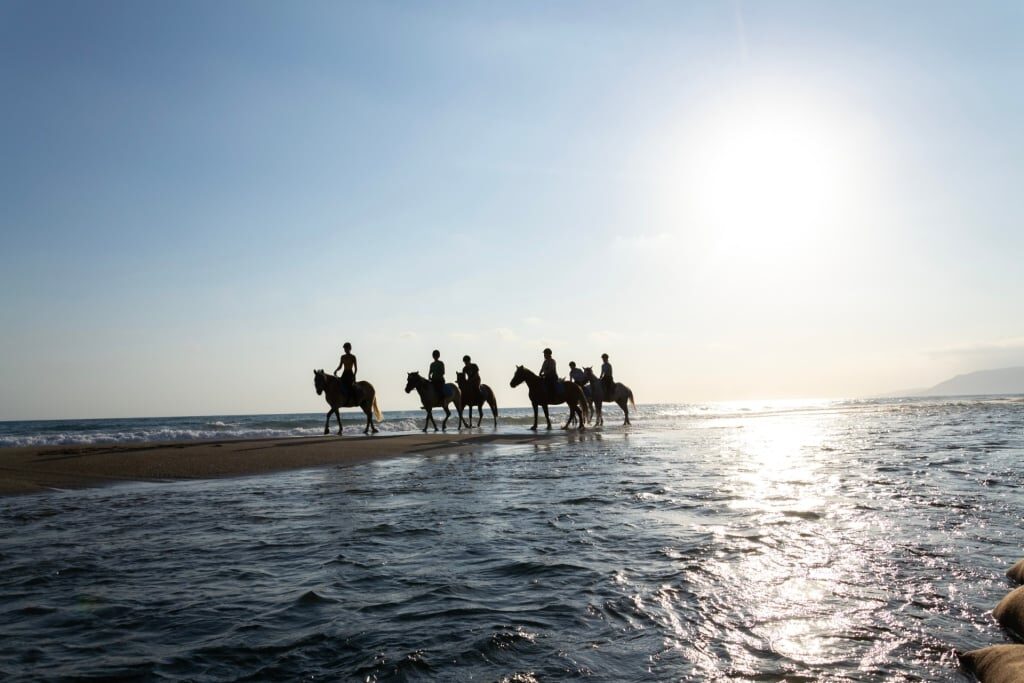
Horseback riding in Georgioupoli
Crete has a longstanding history of horseback riding and the native Messara pony has been on the island for at least 1,000 years. While they were once considered rare, a conservation program has started to increase their numbers.
Sure-footed and comfortable to ride, these ponies are a favorite of the many horseback riding stables that operate around the town of Georgioupoli. Experiences include treks in the countryside, journeys to Lake Kournas, and rides along the beach. Some riding schools even allow riders to enter the waves with their horses.
Admire the Ancient Village of Gavalochori
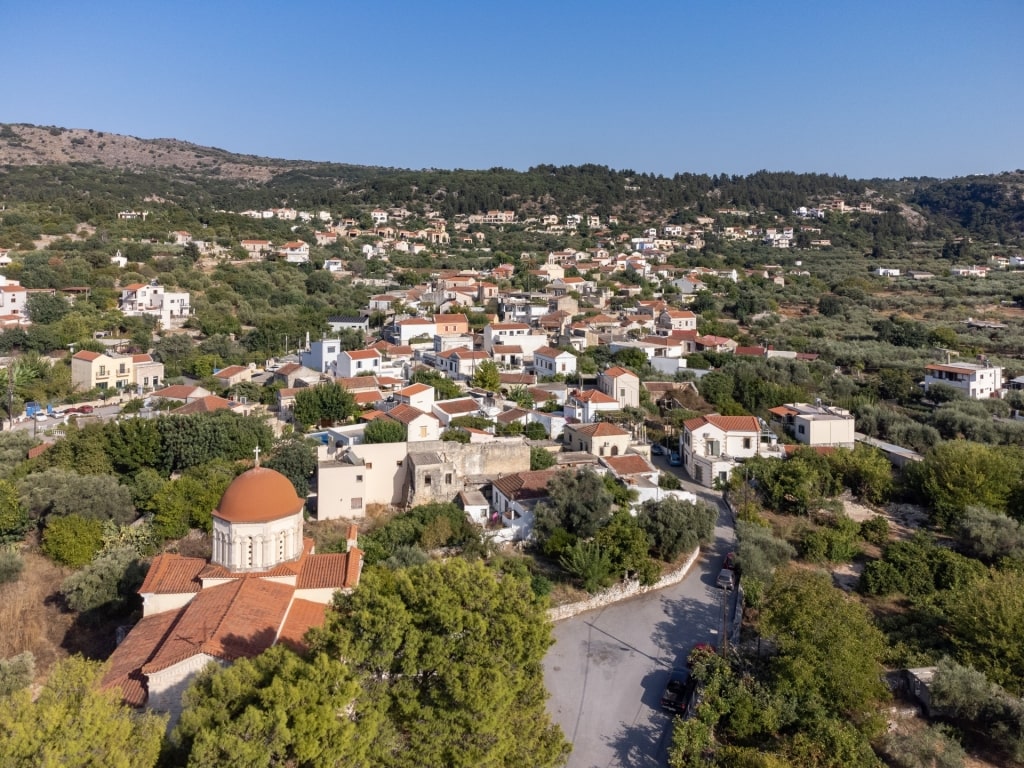
Gavalochori Photo by C messier on Wikimedia Commons, licensed under CC BY-SA 4.0
More than 1,000 years old and with a population of just 350 people, Gavalochori is a typical Cretan village between the coast and the mountains. It’s impossibly pretty with Venetian arches, 14 Orthodox churches, and Roman tombs.
At the local folklore museum you can get an insight into Cretan arts and craft, while there’s also a pre-industrial olive mill that dates from the 17th century. Activities in the area range from visiting modern olive oil producers to art therapy retreats.
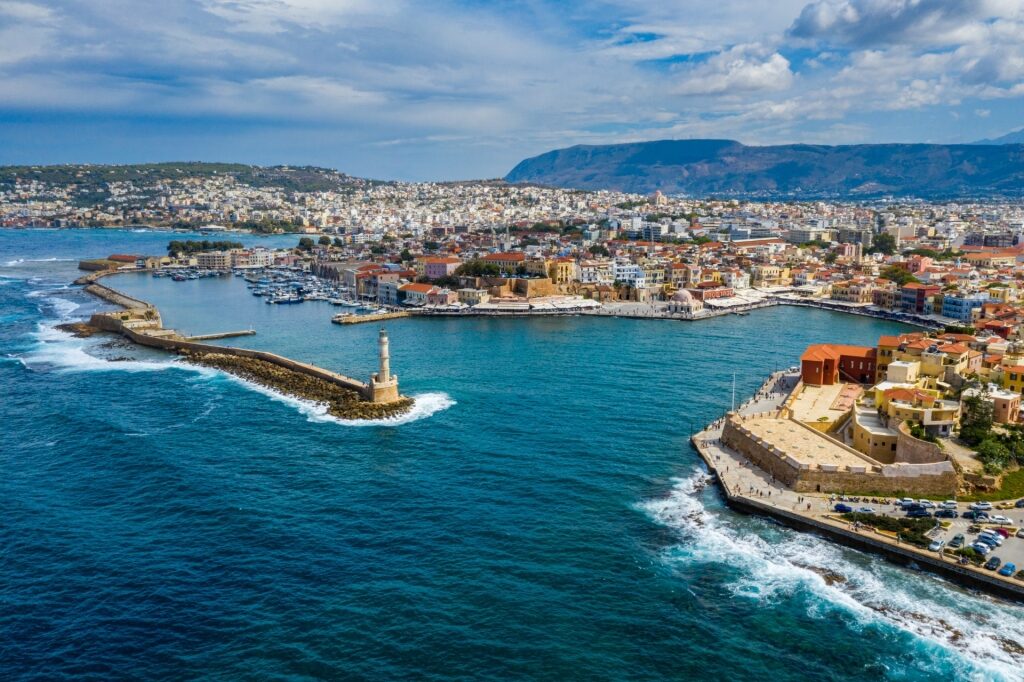
Chania
Discover the many wonderful things to do in Crete, Greece on an exciting cruise with Celebrity. Browse our Crete cruises and plan your Greek odyssey.
